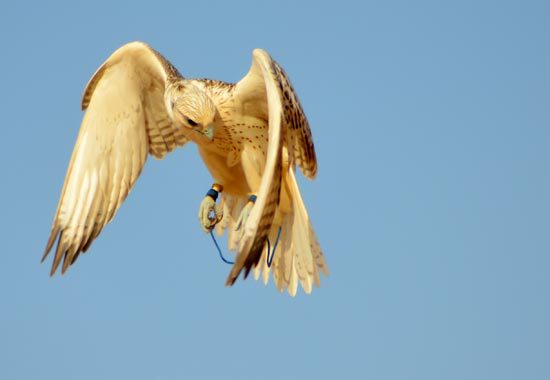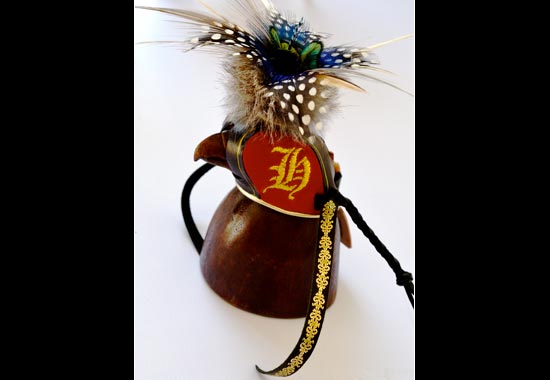New Look at an Old Tradition: 10 Days of Falconry at a Middle East Festival
By Sarah MacLean, Cornell student February 29, 2012

Sarah MacLean's artwork won her a trip to United Arab Emirates for a falconry festival. 

Soon Sarah was sitting in a tent in the desert, talking to Qatari falconers. Photo by Sarah MacLean. 

People from 78 countries attended, including this Mongolian falconer and his Golden Eagle. Photo by Sarah MacLean. 

At the end of the race, a Gyrfalcon pitches into the air to slow down... 

...and then drops to the ground toward the falconry lure. This photo and previous photo by Sarah MacLean. 

A masterfully crafted Japanese falconry hood was one design of many. Photo by Sarah MacLean.
I saw my first Saker Falcon in a tent in the desert, while enjoying cardamom coffee and dates with a group of falconers from Qatar. A young boy was holding the bird on his fist as we sat on the carpet. He was eager to tell us about his horse and his saluki dog, how good they were and how many races they had won. We asked if that was his falcon as well.
“No, this is my father’s falcon,” he told us, beaming proudly, “But soon I will have my own falcon. A saqr.”
The Saker Falcon, or saqr, is a regal species in the Middle East, where falconry has been practiced for more than 6,000 years. Even more revered are the pure white Gyrfalcons, the largest and most powerful of falcons, the birds of kings. Elsewhere in the world, falconers train and hunt with raptors ranging from dove-sized accipiters to massive eagles.
My morning chat with the Qataris provided a narrow glimpse into these traditions, the full breadth of which was on display last December. Falconers from 78 nations had gathered in the United Arab Emirates for the Third International Festival of Falconry.
The birds were unforgettable. But what really struck me about my experience was both the incredible diversity of falconry and how the shared passion of the falconers united them across so many cultures.
Races, living rooms, and beauty contests
In the Middle East, falconry has penetrated into everyday culture. I saw falcons perched in the middle of a living room, on the back of a car seat, and on the arm of a falconer seated at lunch. Falconers discussed an upcoming falcon beauty contest in Abu Dhabi (I still don’t quite understand the judging criteria). The United Arab Emirates has pioneered a falcon passport system, allowing birds to easily travel internationally with their owners. I’m even told that some commercial Middle Eastern airlines allow falcons in the main cabin, where they perch on the falconer’s armrest during flights.
My favorite festival event was falcon racing. One by one, the birds flew across about 500 meters of open desert, their attention trained on the finish line where a falconer swung a lure—a bundle of feathers used in training. I was amazed by how seriously the activity is taken: the owner of the fastest falcon won a new Land Rover, and the second-place falcon lost by a matter of milliseconds. The pinnacle was seeing the falcons reach the end of the course, at which point they pitched straight up into the air, folded their wings, and dived gracefully back down to earth to retrieve the lure.
The culture of falconry gear
I was particularly interested in the everyday falconry equipment on display. The basic types of equipment are amazingly consistent throughout the globe, but the details of the designs are as diverse as the cultures using them. Many falconers wear thick leather gloves to protect their arms from the talons of their birds, but Arabs employ a mangala—a sort of stiff cuff that wraps around the hand. They weave intricate and beautiful designs into many of these mangalas, adding to their artistic and regal air.
Falconry in Asia dates back to at least 1000 BC. For the Asian steppe countries such as Mongolia and Kazakhstan, hunting with Golden Eagles on horseback is still part of everyday life in some nomadic tribes. To carry these big birds, which can weigh 10 pounds, the falconers carve wood or bone props that support their arm at the hip. The Mongolians, like most participants, wore their native dress during exhibitions. Their heavy embroidered robes and fur hats, though fitting for their native climate, must have been arduous to wear in the 80-degree Arabian winter.
Launching a Shikra
Chinese and Japanese falconers traditionally train accipiter hawks, particularly Goshawks. These birds aren’t quite as fast as falcons but are extremely maneuverable. I was amazed to watch some Chinese falconers with their Shikras, small accipiters similar to Sharp-shinned Hawks, which they use in quite an extraordinary way. The falconer first cups the bird in the palm of his hand. The Shikra, perfectly accustomed to the process, crouches patiently in the hand, waiting for the falconer’s signal. Then, with a motion just like throwing a football, the falconer throws the bird toward its target (in this case, a falconry lure). The extra burst of speed gives the little birds an advantage when hunting.
When birds aren’t being flown, falconers place a hood over the head to keep them calm as they stand on a perch or a glove. The Arab, European, and North American hoods largely follow a simple helmet design made from stiff leather, occasionally bearing an ornamentation of beads or leather strips on the crest. The hoods from China have a similar construction, but more complex stitching that creates elegant swirls in the leather. Some of the Japanese hoods were even more artistic, bearing monograms stitched in golden thread and crowns of vibrantly patterned feathers. Such pieces transcend mere utility, becoming an art form unique to falconry.
Falconry equipment, it seems to me, has this ability to be inescapably similar and yet fascinatingly different at the same time, just like the falconers themselves.


All About Birds is a free resource
Available for everyone,
funded by donors like you







